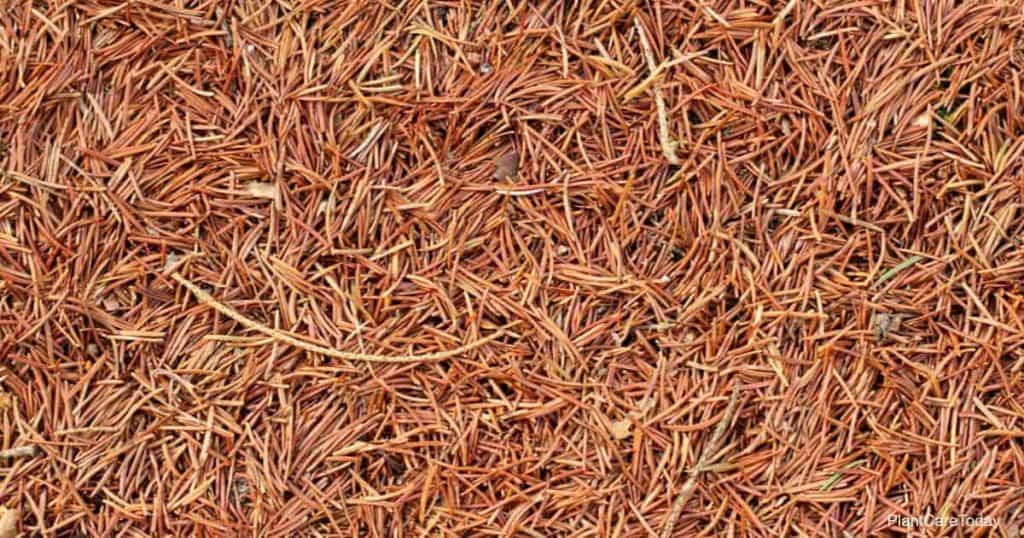Mother Nature has provided numerous natural ways to help plants and trees grow.
One of the most effective ways to ensure the plants grow optimally is mulching them with organic materials to enhance their nutrient content.

Pine needles are one of the most popular organic matters used to create acid soil.
This mulch is cheap and readily available by simply raking the pine straw to gather them.
The pine needle composting takes a long due to its acidic nature, which is why it is considered the best mulch for all acid-loving plants.
Like wood mulch, pine needle mulch is commonly used for lawn care and protecting beds and gardens, even in industrial areas and highways.
It also creates an aesthetic appeal to any landscape due to its muted shades.
What is Pine Needle Mulch?
When the temperature changes in any environment, it affects the quality of the soil. As a result, the plants and trees suffer.
Gardeners utilize numerous types of mulch to enhance the soil’s moisture and nutrients and help the plants grow, especially annual flowers.
Pine straw mulch is a popular garden mulch spread on the ground’s surface to enhance the landscape. It often comes in bales.

Since pine needles insulate the soil, they are ideal for ground covers, vegetable gardens, garden beds, flower beds, landscape beds, and even your front yard.
The pine trees naturally shed pine straw, making it highly inexpensive for numerous gardeners.
Mix pine needles with hay, grass clippings, and straw to create a DIY organic mulch, enhancing their qualities.
Pine straw has plenty of benefits, but it also comes with some disadvantages.
It is essential to understand both sides to ensure you use this mulch the best way possible.
Related: Tips on Getting Pine Sap Out of Clothes
What Are The Pros of Pine Needle Mulch?
There are numerous pine needle mulch pros.

Some of the benefits of pine straw mulch are as follows:
- It is extremely easy and light to spread around than bark mulch or wood chips.
- It is ecologically sound, as there is no need to cut the trees to create or harvest pine needle mulch.
- As the pine needle mulch decomposes, it keeps providing calcium, phosphorus, and nitrogen to the soil.
- All these elements are significant for the healthy development of plants.
- Since it takes time to decompose completely, it lasts much longer than any other type of mulch.
- It prevents the soil surface from getting too dense and compact, allowing it to breathe while maintaining its moisture conservation, soil temperature, and structure.
- It encourages water infiltration into the soil and insulates tender roots.
- A thick layer of pine straw mulch protects the plants from extreme heat and cold.
- It even stays in place during storms and heavy rains, making it excellent on slopes and hills. It also interlocks after spreading.
- It also somewhat protects the plants from weeds.
- Depending on the sun exposure and the pine needles’ quality, the mulch’s color varies from orange to bronze.
- It doesn’t attract pests like termites or diseases like artillery fungus.
- It also reduces runoff and keeps vegetables from forming rot, mildew, and mold.
- This adds a unique and attractive rustic look to your landscape design.
- For many gardeners, this mulch is free of cost if they reside in areas or have planted their own pine trees.
- Moreover, it is also available in the market at an inexpensive rate.
There are numerous appeals to using pine needle mulch per your garden’s needs and requirements.
What Are The Cons of Pine Needle Mulch?
Despite providing numerous benefits, there are also some cons to using this mulch.

Let’s have a look:
- Dry pine needle mulch is tougher and slippery to handle
- It creates a highly acidic soil environment. So add a layer of compost beneath pine needle mulch.
- Even though it is a good mulch for acid-loving plants (Gardenia and Azalea), it may not be ideal for other plants.
- While they provide some protection against weed growth, they are less effective in weed control than other organic mulch since the needles are light and thin.
- The weed effortlessly pushes through unless you pile the surface area with a rather thick layer of mulch.
- However, doing this might enhance the potential for pests.
- You might have to use plant fertilizers to provide complete nutritional elements for numerous plants.
- This mulch turns grayish or silver color as it matures. It might prove unattractive in certain landscapes.
- While this mulch becomes dense and stays firm in heavy rains and storms, reaching this stage takes a long time.
- Initially, it won’t hold well during windy climates.
- The pine needle mulch may become a fire hazard in certain areas since it is created from a natural product.
- It won’t ignite too easily due to its moisture-retaining abilities; however, it is still riskier than other organic matter.
Which Plants Are Suitable for Pine Needle Mulch?
A variety of plants prefer acidic soil to grow, making pine straw mulch ideal for them.

You may use this mulch for the following plants, trees, and shrubs:
- Azaleas
- Hydrangeas
- Rhododendrons
- Marigolds
- Spruce
- Roses
- Daisies
- Zinnias
- Gardenia
- Marigold
- Dogwood
- Fir Trees
- Pine Trees
- Strawberry
- Blueberries
- Snapdragons
- Raspberry
- Potatoes
- Onions
- Tomatoes
It is essential to consider both the pros and cons of pine needle mulch and the type of plants and trees you have in your garden to determine whether or not this mulch is suitable for your needs.
